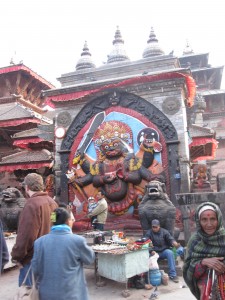The issue of language has come up for us again and again as we try to make sense of our field research. Certainly, we had been expecting something of a language barrier, since none of us students speak more than the very few words of Nepali that our friend from Kathmandu taught us in the pre-departure workshop. However, with our professor speaking Hindi (closely related to Nepali), a large number of interviewees who spoke passable (and at times, extremely good) English, and someone to serve as translator in the majority of our interviews, language issues were not foremost in our minds.
But in retrospect, we are realizing that the language barrier played a significant role in our research. We were able to communicate, certainly, but sometimes the language barrier would rear its head and we would be stalled in frustration. For example, sometimes the interviewees would speak to us in broken English, despite the presence of a translator. At other times, we could sense that the translator was not asking our questions quite how we had phrased them, or not wording the responses in quite the same manner as they had been given. And other times, even when there were no obvious problems, it was simply hard to tell if we understood each other. Did we mean the same thing by the words and concepts we were using?
My research focus during the trip was justice, and my findings on the subject were in some ways disappointing and in nearly all ways far from what I had been expecting. Throughout our interviews, I was left with a nagging feeling that we were not on the same page as far as the concept of justice. I felt that we did not have the same idea of it, that we were not visualizing it in quite the same way, and this was standing in the way of having an open, honest discussion.
But in the end, how much of an effect did language really have on our research, and how can we tell? This is a question I am still struggling with, and I do not have an answer. I do believe that we had these communication problems, but I sometimes wonder if I am using this explanation too much, as an easy way out to explain the difficulty of my research. As I struggle with my findings and analysis of justice in Nepal, I am inclined to say that there was miscommunication, but what if I am using language as a scapegoat, and blaming it for the fact that I heard things I did not want to hear? How can we ever really know how much of a role the language barrier played in our research?







